![]()
![]()
![]()
Use LEFT and RIGHT arrow keys to navigate between flashcards;
Use UP and DOWN arrow keys to flip the card;
H to show hint;
A reads text to speech;
50 Cards in this Set
- Front
- Back
|
The ___________ is the most superficial muscle of the back. |
trapezius |
|
|
Its inferior portion covers the superior section of the latissimus dorsi. |
trapezius |
|
|
the main retractors/adductors of the scapula |
rhomboids (major & minor) |
|
|
the only muscles on the anterior side of the body that move or stabilize the scapula |
Serratus anterior & pectoralis minor |
|
|
_____________ is known as the “hugging” muscle. Weakness of this muscle can cause “winged scapula”.
|
Serratus anterior |
|
|
pectoralis minor syndrome |
-compression of the vessels and nerves -one of the types of thoracic outlet syndrome (TOS)
|
|
|
|
Rounded shoulders |
|
|
Elevates ribs #3 to #5 expanding the ribcage & thoracic cavity = more space for lung expansion. Accessory muscle of respiration. |
pectoralis minor |
|
|
Muscles that move the shoulder girdle stabilize the ___________ & ____________. |
scapula & clavicle |
|
|
The only joint in the pectoral girdle that articulates with the axial skeleton |
sternoclavicular joint |
|
|
Scapula and clavicle are held in place by muscles that originate from ____________ |
the axial skeleton |
|
|
Trapezius origins |
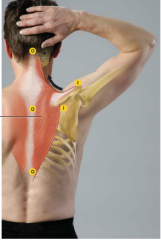
up: ext occip protub lig nuch
mid: Sp
low: Sp to T12
|
|
|
Trapezius insertion |

up: lat clav, acromion
mid: spine of scap
low: root of spine
|
|
|
Rhomboid major origin |
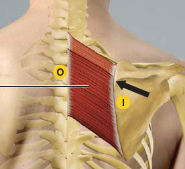
Sp T2-5 |
|
|
Rhomboid major insertion |
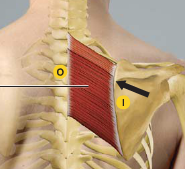
Vertebral border from root of spine to inferior angle |
|
|
Rhomboid minor origin |
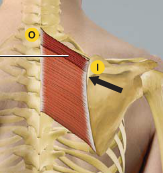
Sp C7 & T1 |
|
|
Rhomboid minor insertion |
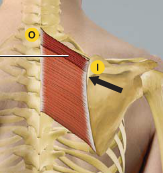
vertebral border at root of spine |
|
|
Levator scapula origin |
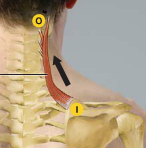
Tp C1-4 |
|
|
Levator scapula insertion |
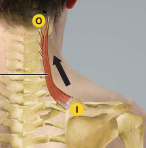
Vertebral border from superior angle to root of spine |
|
|
Serratus anterior origin |

Upper 8 ribs
(anterior & superior aspect) |
|
|
Serratus anterior insertion |
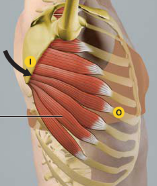
Costal/anterior side of scapula on vertebral border.
|
|
|
Pectoralis minor origin |
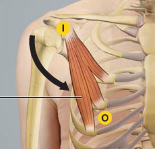
Anterior aspect of 3rd, 4th & 5th ribs |
|
|
Pectoralis minor insertion |
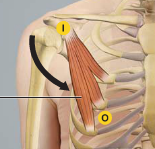
Coracoid process |
|
|
_______________ and ____________ entrap the brachial plexus |
pectoralis minor & scalenes |
|
|
neurovascular bundle (including the brachial plexus) passes under the muscle and between the _____________ & _________. |
Clavical & ribs |
|
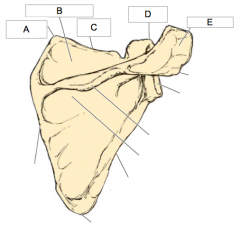
|
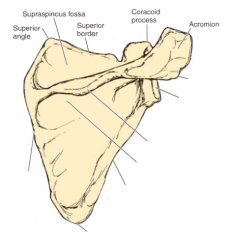
|
|

|
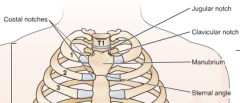
|
|
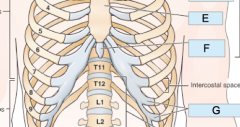
|

|
|
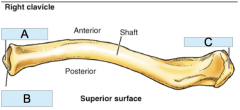
|
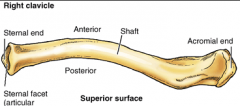
|
|
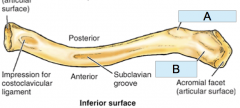
|
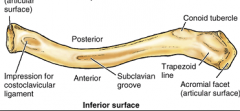
|
|
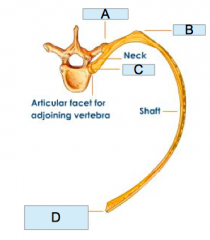
|
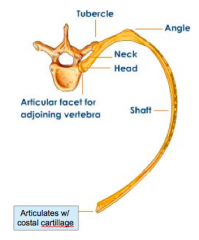
|
|
|
Not a true synovial joint. Where the scapula slides over the ribs/thorax. |
Scapulothoracic joint |
|
|
synovial gliding joint between the acromion and the acromial end of the clavicle. |
Acromioclavicular joint |
|
|
synovial gliding joint between clavicular notch of sternum and sternal end of clavicle. |
Sternoclavicular joint |
|
|
5 muscles that are primarily involved in shoulder girdle movements |
trapezius rhomboids levator scapula serratus anterior pectoralis minor |
|
|
For some shoulder girdle movements, the scapula must ________________________________. |
rotate or tilt on its axis |
|
|
Scapulohumeral Rhythm |
Scapular rotation that accompanies and facilitates humeral abduction.
Helps to achieve further range of movement. |
|
|
Head of humerus and glenoid fossa/cavity of scapula make up the _____________ joint. |
glenohumeral |
|
|
True or false: The shoulder joint is a synovial ball and socket joint. |
True |
|
|
subacromial & subdeltoid bursitis
|
inflammation of bursa that separates superior surface of supraspinatus tendon from the coraco-acromial ligament, acromion, coracoid and the deep surface of the deltoid muscle. |
|
|
winged scapula |
the shoulder blade, or shoulder bone, protrudes from a person's back in an abnormal position. |
|
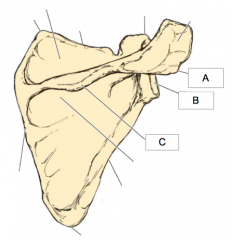
|
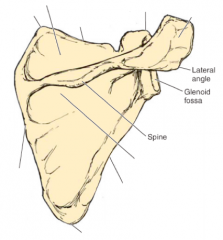
|
|

|

|
|
|
serratus anterior action on scapula |
abducts upwardly rotates |
|
|
pectoralis minor action on scapula |
draws it forward & down |
|
|
levator scapula action on scapula |
elevates vertebral border pulls it upward & medially bends neck laterally (side tilt) |
|
|
upper trapezius action on scapula |
elevates upwardly rotates
|
|
|
middle trapezius action on scapula |
adduct |
|
|
lower trapezius action on scapula |
depress upward rotate |
|
|
rhomboids action on scapula |
retracts elevates |

